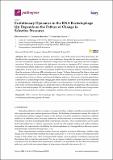Por favor, use este identificador para citar o enlazar a este item:
http://hdl.handle.net/10261/185031COMPARTIR / EXPORTAR:
 SHARE SHARE
 CORE
BASE CORE
BASE
|
|
| Visualizar otros formatos: MARC | Dublin Core | RDF | ORE | MODS | METS | DIDL | DATACITE | |

| Título: | Evolutionary dynamics in the RNA bacteriophage Qβ depends on the pattern of change in selective pressures |
Autor: | Somovilla, Pilar; Manrubia Cuevas, Susanna CSIC ORCID ; Lázaro, Ester CSIC ORCID | Palabras clave: | RNA viruses Bacteriophage Qβ Adaptation Pattern of change Fitness dynamics Evolutionary pathways Genetic diversity |
Fecha de publicación: | 18-jun-2019 | Editor: | Multidisciplinary Digital Publishing Institute | Citación: | Pathogens 8(2): 80 (2019) | Resumen: | The rate of change in selective pressures is one of the main factors that determines the likelihood that populations can adapt to stress conditions. Generally, the reduction in the population size that accompanies abrupt environmental changes makes it difficult to generate and select adaptive mutations. However, in systems with high genetic diversity, as happens in RNA viruses, mutations with beneficial effects under new conditions can already be present in the population, facilitating adaptation. In this work, we have propagated an RNA bacteriophage (Qβ) at temperatures higher than the optimum, following different patterns of change. We have determined the fitness values and the consensus sequences of all lineages throughout the evolutionary process in order to establish correspondences between fitness variations and adaptive pathways. Our results show that populations subjected to a sudden temperature change gain fitness and fix mutations faster than those subjected to gradual changes, differing also in the particular selected mutations. The life-history of populations prior to the environmental change has great importance in the dynamics of adaptation. The conclusion is that in the bacteriophage Qβ, the standing genetic diversity together with the rate of temperature change determine both the rapidity of adaptation and the followed evolutionary pathways. | Descripción: | © 2019 by the authors. | Versión del editor: | https://doi.org/10.3390/pathogens8020080 | URI: | http://hdl.handle.net/10261/185031 | DOI: | 10.3390/pathogens8020080 | ISSN: | 2076-0817 | E-ISSN: | 2076-0817 |
| Aparece en las colecciones: | (CAB) Artículos (CNB) Artículos |
Ficheros en este ítem:
| Fichero | Descripción | Tamaño | Formato | |
|---|---|---|---|---|
| Evolutionary_Somovilla.pdf | 1,84 MB | Adobe PDF |  Visualizar/Abrir |
CORE Recommender
PubMed Central
Citations
5
checked on 25-abr-2024
SCOPUSTM
Citations
7
checked on 19-abr-2024
WEB OF SCIENCETM
Citations
7
checked on 29-feb-2024
Page view(s)
219
checked on 24-abr-2024
Download(s)
164
checked on 24-abr-2024

